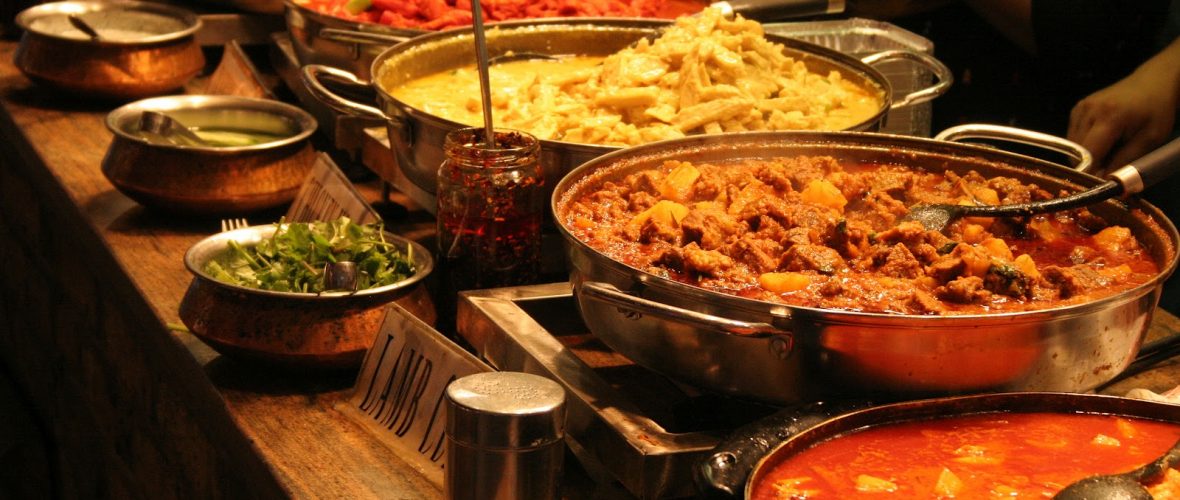Indian cuisine is ancient, diverse, and steeped in tradition, an amalgam of different ethnic influences, much like the country itself. The spicy food displayed at buffets in the US, or the ubiquitous “curry” in Britain are only a small fraction of the variety and quality available to food lovers.
Gourmet Indian food is typically associated with the food cooked in the courts of Indian royalty, particularly those of Mughal emperors in Delhi and Lucknow in North India and the Nizams of Hyderabad in the South. This food is characterized by elaborate cooking techniques and the use of expensive ingredients. However, there are thousands of hidden culinary gems to be found in kitchens, little-known restaurants, and places of worship around the country that require a discriminating palate and hence can be classified as ‘gourmet’. Religion and climate are two factors that have significantly impacted the development of cooking styles and food habits in India.
RELIGIOUS AND FOREIGN INFLUENCES ON INDIAN FOOD
Over 80% of Indians follow the Hindu religion and its offshoots such as Jainism. Hinduism prescribes respect for life forms and has contributed to the prevalence of vegetarianism in India, particularly in the North. One impact of this on cuisine is that lentils and beans are the main sources of protein as opposed to fish and meat. Although cows are sacred to Hindus, milk is considered auspicious and milk products such as curd, vegan cottage cheese (‘paneer’) and sweets made of milk solids are part of the cuisine. Spices are generously used to provide variety in the vegetarian diet. Certain sects of Hinduism forbid the use of onions and garlic in food, and so substitute flavorings such as cumin seeds, ginger, and cashew paste have been incorporated into the cuisine.
With Muslim rule established in India in 1194 AD, the cuisine began to reflect Islamic influences. The main difference from traditional Hindu cuisine was the use of meat and fish. West and Central Asian cooking techniques and ingredients (such as the use of dates and nuts in rice dishes, and grilling of meat into ‘kebabs’) were adopted. Muslim rulers were great gourmets, famous for their lavish courts and elaborate meal rituals and many of the dishes they patronized are today part of the Indian gourmet heritage. The Christian tradition in India is as old as Christianity itself, with St. Thomas reputed to have made the first converts to Christianity in the Southern state of Kerala. Later, the Portuguese and British accelerated the growth of Christianity. Like the Muslims, Christians ate meat and fish, but developed their own cooking techniques. In Kerala, where Christianity took root over time and in tandem with local culture, food incorporates many local ingredients and cooking techniques and has few European influences. In Goa and Calcutta, where Christianity came with the British and Portuguese and conversion happened more rapidly, food reflects European customs and traditions (for example, rum-flavored cake is a traditional favorite at Christmas in Calcutta). Unlike Muslims who are prohibited from eating pork, and Hindus who are vegan, Christians have no restrictions on the type of meat that can be consumed.
Religious festivals – whether Hindu, Muslim, or Christian – often have special foods associated with them linked to the mythology of that occasion. For example milk and milk products are said to be favored by Lord Krishna, and so on ‘Krishna Jayanti’ (Krishna’s birthday), food and sweets prepared from dairy products predominate. Similarly for Muslims, there are special foods called ‘Iftari’ for breaking the Ramadam fast (or ‘iftar’) such as ‘Seviyan’ (sweet vermicelli cooked in milk).

